|
|
Post by Cei-U! on Jun 3, 2024 15:10:40 GMT -5
"The Three Sandmen" is such a complete aberration, especially when considered in the context of the rest of the series (you're right, they never appear and are never mentioned again), that I consider it non-canonical. In fact, I find myself wondering if it wasn't a repurposed pilot (you should forgive the pun) for "The Three Aces." Either way, I'm with you, chad. I don't think it's a good story, even for that period.
Cei-U!
I summon the dud!
|
|
|
|
Post by MWGallaher on Jun 3, 2024 16:44:24 GMT -5
Here's my best Roy Thomas-ization: one of Teeter's unidentified pilot cohorts later tangled with The Sandman, and Wesley then found it conveniently intimidating to claim credit for the fate of the late Mr. Sneed, although the avenging aviators were in fact The Three Aces. Word circulated in gangdom and this incident became part of the myth of the mysterious Sandman.
It does appear that Christman wanted to set stories in his preferred environments--swimming and flying--even if they weren't all that appropriate to the character. Perhaps getting his Three Aces in print was the outlet he needed for his aviation stories, permitting The Sandman to get back into a more fitting milieu.
|
|
|
|
Post by codystarbuck on Jun 3, 2024 20:26:04 GMT -5
Thank you for saying "naval aviator" and not "pilot." Naval aviators were a different breed.
They still talk with their hands, though.
You can tell by the planes he drew that he knew his subject. They were not the usual generic stuff; but actual models. The one biplane appears to be an F3F, which was flown from 1936-1941, replaced by the Brewster Buffalo, then the F4 Wildcat, which was the workhorse of naval aviation, even after the Hellcats and Corsairs were introduced, since they could fly off the smaller escort carriers.
|
|
|
|
Post by chadwilliam on Jun 5, 2024 10:59:50 GMT -5
Adventure Comics #43 (October 1939) "Island Uprising"
Author: Bert Christman Artist: Bert Christman "Vacationing in the South Sea, Wesley Dodd one day flies to a lonely island - his plane scarcely stops rolling on the smooth beach where he hands, when a hysterical girl breaks from the jungle and runs toward him - then... an arrow spills her in his arms....."
Synopsis: Her two bowmen attackers are quickly felled by Wesley Dodd's revolver and the unconscious girl's wounds tended to, our hero waits for his charge to recover so he can learn her story. The reader however, doesn't have so long to wait. On the other side of the island where his pearl harbour is to be found, harbour boss, Nelson grows ever more worried as to the whereabouts of his daughter, Australia. Having not been sighted since she went for a walk some time ago, two of his men, Piper and Knute, decide to search for her.
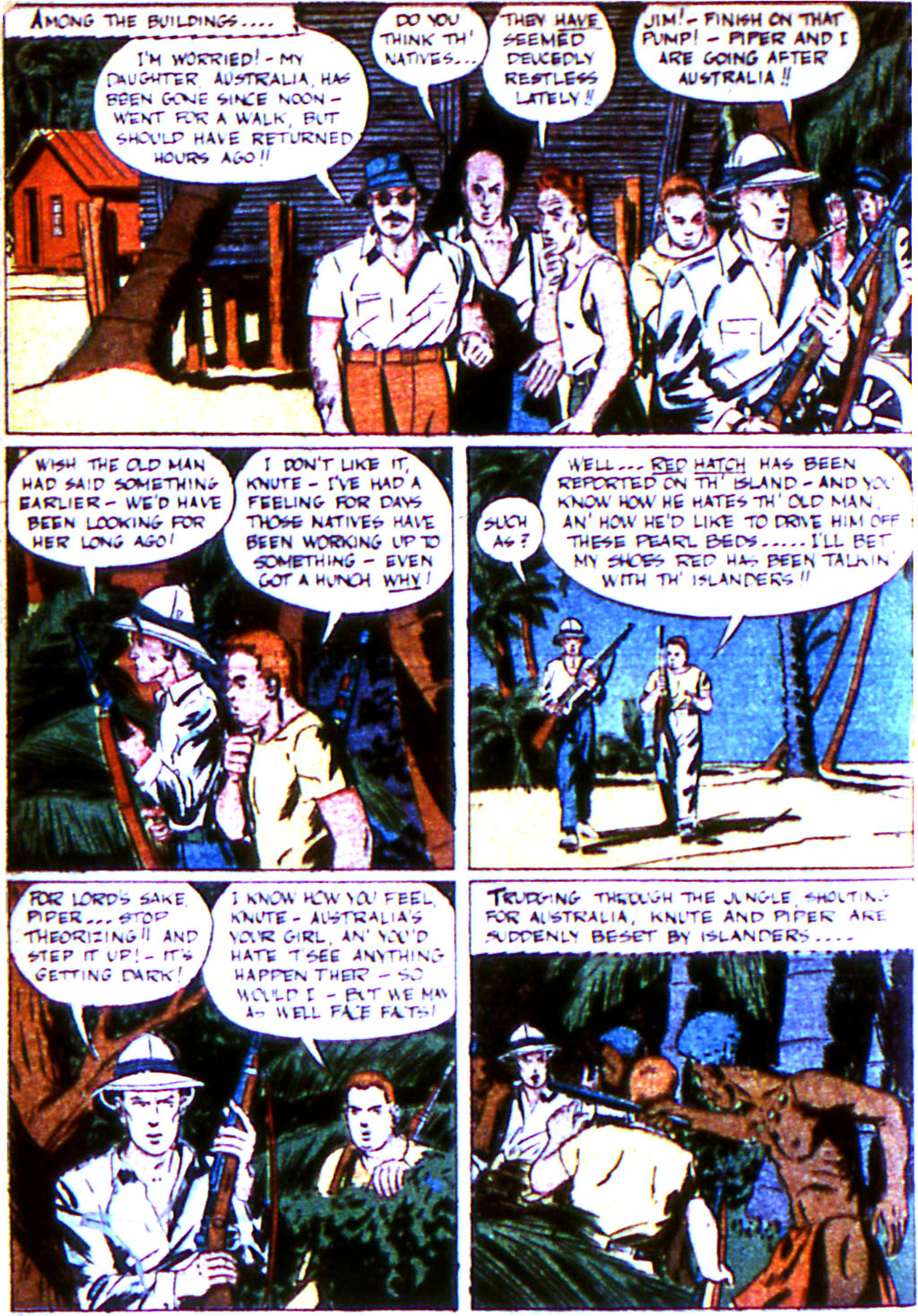
"I don't like it, Knute - I've had a feeling for days those natives have been working up to something - even got a hunch why."
When pressed upon this last point, Piper theorizes that Nelson's rival, Red Hatch, has been conspiring with the inhabitants of this island to acquire its valued pearls. Before a skeptical Knute can counter his friend's suggestion with a less sinister proposition, the pair are set up by islanders. Presented before Red Hatch, Piper's guess becomes fact though there is to be taken no solace from their captor's words. Pointing to the men at his command, Red Hatch proclaims: "See those crazy, dancing savages?! - They're not all heated up fer nothin' - they're goin' t'wipe out Nelson's whole outfit!! Tonight!!"
Inviting Piper and Knute along, the party sets out to Nelson's storehouse where a group of 14 - alerted to their predicament by the sound of war drums - prepare to defend themselves against Red Hatch's estimated army of "over two hundred". However, when "a great bird flashes overheard, dropping fire", those odds become a little bit favourable especially when Knute shouts Red Hatch's men that "the great God is angry! He will punish you for attacking the white men!" 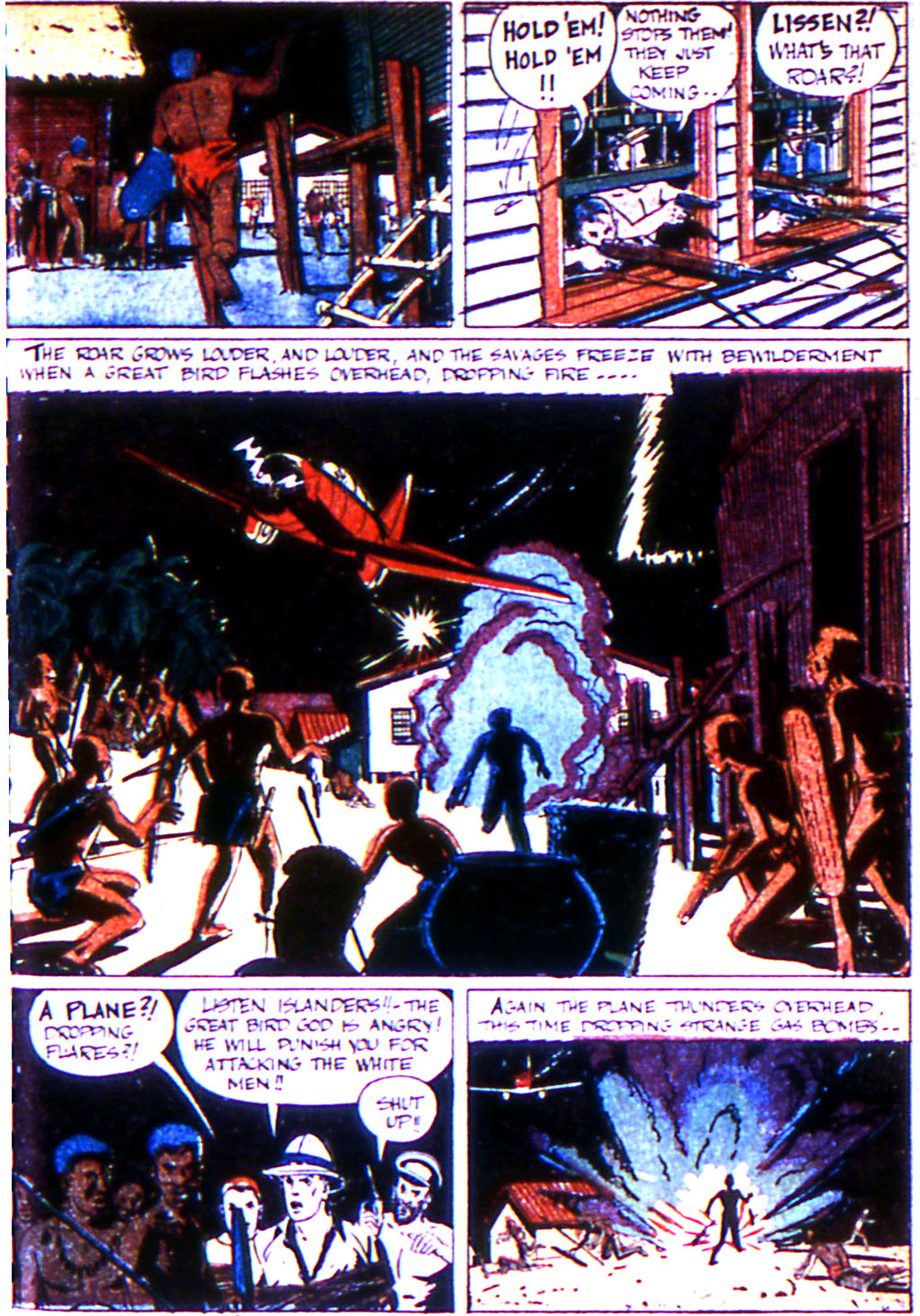 The bluff does its trick and one of the islanders turns towards Red Hatch, announces his anger, and kills him. When the giant metal bird sets down, the islanders bow before it and the God who steps out from within, carrying Australia in his arms - The Sandman. The threat vanquished and the islanders either cowering from a distance or laid prostrate before him thanks to their terror and effects of his gas bombs, The Sandman advises Nelson accordingly: "Tell the natives The Sandman will return and punish them if they continue to war against the white man - tell them their faintness will leave them with no ill effects if they are good..."
Remarking that "the islanders think he's a God!", one of Nelson's men suggests that that may be just what he "kind of" is. 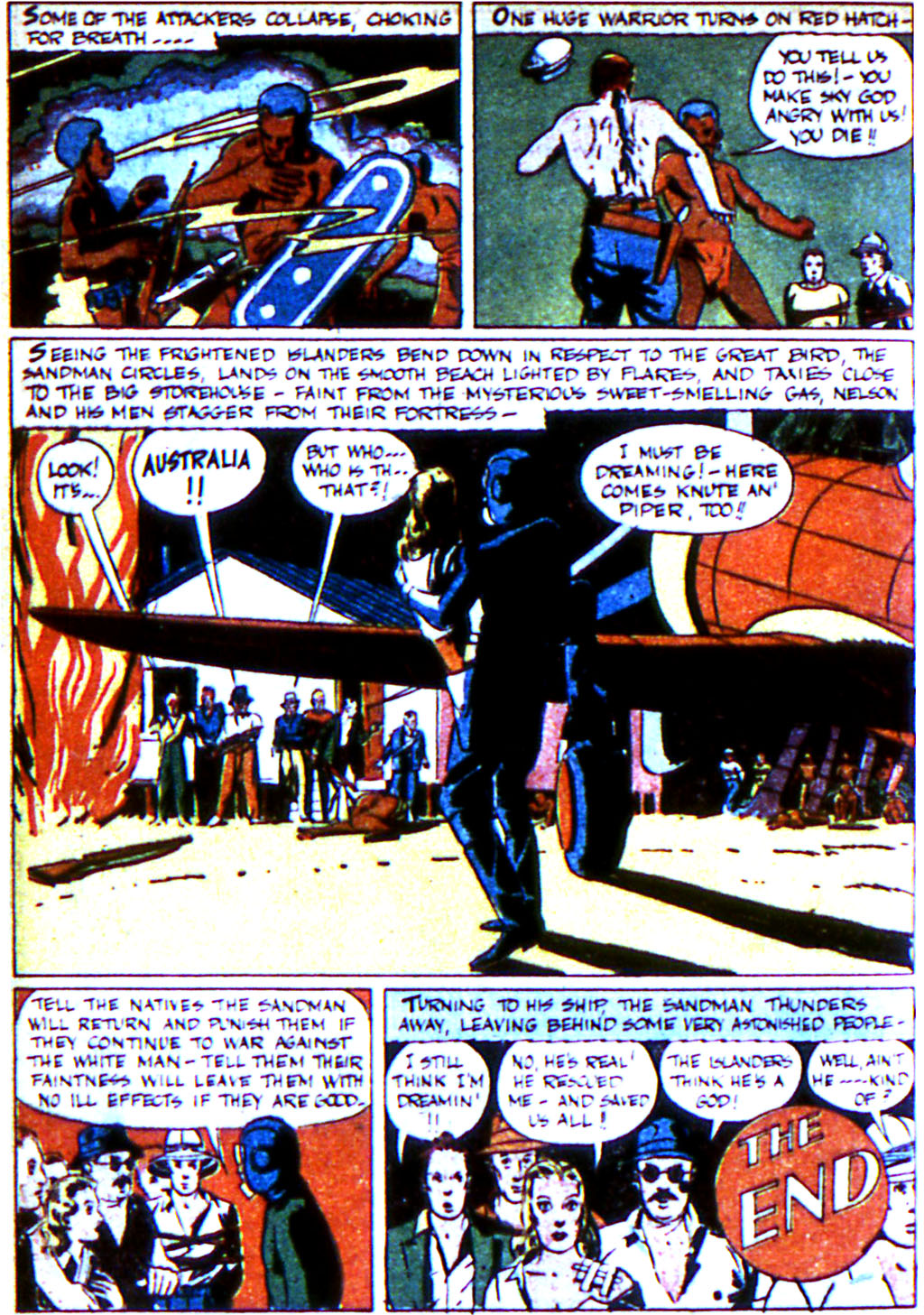 Thoughts Thoughts: Gunning down two of the islanders at the start of this tale brings, I think, The Sandman's kill count to four (assuming that he did kill Tipper in issue #41 and that member of Teeter's flying troupe in #42) which undercuts Jim Amash's assertion that Wesley Dodds (who is given the surname of "Dodd" in this installment) was perhaps a little tamer than his counterparts, The Shadow and The Spider. If that seems like a little bit of a morbid statistic to bring up in this review, I will point out that with The Sandman appearing only briefly at the start and close of this tale, I'm hard pressed to come up with much more to add than that as Christman pens his second in a row of 'The Sandman as Flying Ace' stories - understandable since this is a medium the artist/writer knew well. I've been commenting that it should be obvious by even these early days what sort of roles The Sandman was born to play, but I'm not so sure that's true. What exactly does Christman have to draw upon in terms of comic book mystery men at this point in time? A smattering of Bat-Man stories? Some Crimson Avenger escapades? Other than Superman, who amongst this developing handful of superheroes is there to glean an idea from of what a superhero story should be? I respect Christman for offering something different in a medium which will soon become flooded with clichés and overly used tropes but I just don't think it works. Unfortunately, this issue will mark Christman's last for the series. As Jim Amash observed in his Sandman Archives foreword, this one:
"was an obvious rush job. There are fewer panels per page, and the inking has a hurried look to it. Christman was on his way out the door as he pursued his dream of becoming an aviator, eventually joining The Flying Tigers. He died after parachuting from his plane on January 23, 1942, in Rangoon, Burma."And with that, this review doesn't seem all that pressing anymore. I will remark though, that Christman was a wonderful illustrator who extracted the essence of The Sandman and all of the possibilities to be found in such a character perfectly. His designs, his lighting, the way his characters moved not only imbued them with such a heavy weight of mystery and sinisterness when needed, but also created a world you could confidentially and unashamedly be frightened of containing shadows whose contents you could be gratefully oblivious to. I wish he could have carried on with the strip and more importantly, I wish he hadn't died at only the age of 26. I'll end things there.
|
|
|
|
Post by codystarbuck on Jun 5, 2024 12:15:58 GMT -5
I suspect the name Australia (who names their kid Australia? Just going to end in a lot of "down under" jokes) is a nod to Burma, in Terry & The Pirates.
|
|
|
|
Post by Cei-U! on Jun 5, 2024 13:36:29 GMT -5
Man, that is one racist story. Par for the course for that era, but still...
Cei-U!
I summon the cringiness!
|
|
|
|
Post by chadwilliam on Jun 5, 2024 16:21:28 GMT -5
Man, that is one racist story. Par for the course for that era, but still... Cei-U! I summon the cringiness! Here's hoping that this will prove to be another "aberration" I'll be able to ignore. |
|
|
|
Post by MWGallaher on Jun 6, 2024 11:35:34 GMT -5
I've been commenting that it should be obvious by even these early days what sort of roles The Sandman was born to play, but I'm not so sure that's true. What exactly does Christman have to draw upon in terms of comic book mystery men at this point in time? A smattering of Bat-Man stories? Some Crimson Avenger escapades? Other than Superman, who amongst this developing handful of superheroes is there to glean an idea from of what a superhero story should be? I respect Christman for offering something different in a medium which will soon become flooded with clichés and overly used tropes but I just don't think it works. I wish we had a better handle on the timeline of production on this feature. It appears that Christman began his training at the Naval Air Station in Pensacola, Florida, in June 1938--one month after Superman first appeared on the newsstands. Did he draw this (and "Three Aces") while he was in training as an aviation cadet? It's hard to imagine a new enlistee in what I would guess was a pretty intensive program still moonlighting as a comic book artist! It's hard to imagine that National would have employed an artist they knew was producing his pages under those circumstances. But it's also hard to imagine that Christman's stories were already a year old before they saw print (which means they would have been prepared before Superman was unleashed on the world!). I can't make any reliable deductions from this timeline. |
|
|
|
Post by codystarbuck on Jun 6, 2024 13:02:13 GMT -5
I've been commenting that it should be obvious by even these early days what sort of roles The Sandman was born to play, but I'm not so sure that's true. What exactly does Christman have to draw upon in terms of comic book mystery men at this point in time? A smattering of Bat-Man stories? Some Crimson Avenger escapades? Other than Superman, who amongst this developing handful of superheroes is there to glean an idea from of what a superhero story should be? I respect Christman for offering something different in a medium which will soon become flooded with clichés and overly used tropes but I just don't think it works. I wish we had a better handle on the timeline of production on this feature. It appears that Christman began his training at the Naval Air Station in Pensacola, Florida, in June 1938--one month after Superman first appeared on the newsstands. Did he draw this (and "Three Aces") while he was in training as an aviation cadet? It's hard to imagine a new enlistee in what I would guess was a pretty intensive program still moonlighting as a comic book artist! It's hard to imagine that National would have employed an artist they knew was producing his pages under those circumstances. But it's also hard to imagine that Christman's stories were already a year old before they saw print (which means they would have been prepared before Superman was unleashed on the world!). I can't make any reliable deductions from this timeline. It's possible that he could have worked on some material, while training and carrying out his military duties. It's also possible that he had done some work earlier that was published later. The Aviation Cadet Act was established in 1938, which allowed for commissioning upon completion of training, to build up aviation forces. The training time for flight school was reduced from 12 months to 6 months. If Christman had some lead time, before entering the program, he might have knocked out some stories ahead of time, like Simon & Kirby, when they got their draft notices. He might have worked on them in his down time, after flight school, but that seems less likely, given his duties, which would have included other areas, including watchstanding for his squadron. He was eventually assigned to the USS Ranger. He has a total of 11 stories published by DC/All-American, between 1938 and 1940, based on cover dates. The stories are about 6 pages. Not exactly a ton of work to produce; they could have easily been stockpiled; or, just as easily, been cranked out over a day or two. Either scenario is plausible. |
|
|
|
Post by chadwilliam on Jun 6, 2024 22:52:44 GMT -5
I wish we had a better handle on the timeline of production on this feature. It appears that Christman began his training at the Naval Air Station in Pensacola, Florida, in June 1938--one month after Superman first appeared on the newsstands. Did he draw this (and "Three Aces") while he was in training as an aviation cadet? It's hard to imagine a new enlistee in what I would guess was a pretty intensive program still moonlighting as a comic book artist! It's hard to imagine that National would have employed an artist they knew was producing his pages under those circumstances. But it's also hard to imagine that Christman's stories were already a year old before they saw print (which means they would have been prepared before Superman was unleashed on the world!). I can't make any reliable deductions from this timeline. It's possible that he could have worked on some material, while training and carrying out his military duties. It's also possible that he had done some work earlier that was published later. The Aviation Cadet Act was established in 1938, which allowed for commissioning upon completion of training, to build up aviation forces. The training time for flight school was reduced from 12 months to 6 months. If Christman had some lead time, before entering the program, he might have knocked out some stories ahead of time, like Simon & Kirby, when they got their draft notices. He might have worked on them in his down time, after flight school, but that seems less likely, given his duties, which would have included other areas, including watchstanding for his squadron. He was eventually assigned to the USS Ranger. He has a total of 11 stories published by DC/All-American, between 1938 and 1940, based on cover dates. The stories are about 6 pages. Not exactly a ton of work to produce; they could have easily been stockpiled; or, just as easily, been cranked out over a day or two.
Either scenario is plausible. From Jim Amash's persepctive (care of his foreword to The Sandman Archives Vol.1):
"The last Christman-drawn story appears in Adventure Comics #43 and was an obvious rush job. There are fewer panels per page, and the inking has a hurried look to it. Christmas was on his way out the door as he pursued his dream of becoming an aviator, eventually joining The Flying Tigers."
I noticed the expansive panels used in his last two stories but what with these being tales of the sky I wasn't certain whether this was an artistic choice or economical one. |
|
|
|
Post by MWGallaher on Jun 7, 2024 15:29:58 GMT -5
It's possible that he could have worked on some material, while training and carrying out his military duties. It's also possible that he had done some work earlier that was published later. The Aviation Cadet Act was established in 1938, which allowed for commissioning upon completion of training, to build up aviation forces. The training time for flight school was reduced from 12 months to 6 months. If Christman had some lead time, before entering the program, he might have knocked out some stories ahead of time, like Simon & Kirby, when they got their draft notices. He might have worked on them in his down time, after flight school, but that seems less likely, given his duties, which would have included other areas, including watchstanding for his squadron. He was eventually assigned to the USS Ranger. He has a total of 11 stories published by DC/All-American, between 1938 and 1940, based on cover dates. The stories are about 6 pages. Not exactly a ton of work to produce; they could have easily been stockpiled; or, just as easily, been cranked out over a day or two.
Either scenario is plausible. From Jim Amash's persepctive (care of his foreword to The Sandman Archives Vol.1):
"The last Christman-drawn story appears in Adventure Comics #43 and was an obvious rush job. There are fewer panels per page, and the inking has a hurried look to it. Christmas was on his way out the door as he pursued his dream of becoming an aviator, eventually joining The Flying Tigers."
I noticed the expansive panels used in his last two stories but what with these being tales of the sky I wasn't certain whether this was an artistic choice or economical one. If Amash is saying that he finished this before he enlisted, and if the reports of him reporting to Pensacola in June 1938 are correct, then all of his stories were finished a year before the first ones saw print. That would put his entire comics production pre-Action Comics #1. |
|
|
|
Post by Cei-U! on Jun 7, 2024 20:19:07 GMT -5
From Jim Amash's persepctive (care of his foreword to The Sandman Archives Vol.1):
"The last Christman-drawn story appears in Adventure Comics #43 and was an obvious rush job. There are fewer panels per page, and the inking has a hurried look to it. Christmas was on his way out the door as he pursued his dream of becoming an aviator, eventually joining The Flying Tigers."
I noticed the expansive panels used in his last two stories but what with these being tales of the sky I wasn't certain whether this was an artistic choice or economical one. If Amash is saying that he finished this before he enlisted, and if the reports of him reporting to Pensacola in June 1938 are correct, then all of his stories were finished a year before the first ones saw print. That would put his entire comics production pre-Action Comics #1. ...in which case, it may have been held in inventory until the sales on Action prompted Sullivan & Co. to cast about for a mystery man to headline Adventure.
Cei-U! I summon the hypothesis!
|
|
|
|
Post by MWGallaher on Jun 7, 2024 21:58:01 GMT -5
If Amash is saying that he finished this before he enlisted, and if the reports of him reporting to Pensacola in June 1938 are correct, then all of his stories were finished a year before the first ones saw print. That would put his entire comics production pre-Action Comics #1. ...in which case, it may have been held in inventory until the sales on Action prompted Sullivan & Co. to cast about for a mystery man to headline Adventure. Cei-U! I summon the hypothesis!
Suppose then that Bert Christman had already finished those first five Sandman stories prior to giving up his comics career for naval aviation in June 1938. Given that DC's first costumed mystery man to see print, The Crimson Avenger, debuted in Detective Comics #20, on sale in September 1938, there would be a strong possibility that The Sandman was National's real first mystery man, from the perspective of being the first one for whom completed stories were prepared. (Yes, The Crimson may also have been held in inventory just as we are supposing The Sandman was, but it may also be the case that Jim Chambers only started on that material sometime after June 1938, which would still give it time to see print in September.) Like The Sandman, The Crimson Avenger incapacitated his foes with sleeping gas fired from a gun. Both, obviously, "borrowed" this from radio's popular Green Hornet, but The Crimson was a much more explicit imitation: newspaper publisher with an Asian sidekick/chauffeur and with a color in his hero name (but at least "Crimson Avenger" wasn't quite as blatant as "Blue Beetle" or "Red Bee"!). In this supposition, we might imagine that Sullivan liked Christman's Sandman idea, but held back on it and instead directed Chambers to produce something even closer to the Hornet, then dug The Sandman out of inventory when mystery men started taking off. It's all supposition, but it's intriguing to think that The Sandman might have preceded and directly inspired the character that has been commonly recognized as the first of the DC mystery men. |
|
|
|
Post by Cei-U! on Jun 8, 2024 2:21:48 GMT -5
By the way, I discovered while researching my book that "blue beetle" was slang in the late '20s/early '30s for a police patrol car. So the use of that name for a mystery man (whose alter ego was a rookie cop) served another purpose in addition to evoking the Green Hornet.
Cei-U!
I summon the antique pun!
|
|
|
|
Post by chadwilliam on Jun 9, 2024 0:02:18 GMT -5
 Adventure Comics #44 Adventure Comics #44 (November 1939) " The Sandman Meets The Face"
Author: Gardner Fox Artist: Creig Flessel Cover: Creig Flessel "The Sandman is an unknown and mysterious figure, warring with criminals - and almost at times, it seems, with the police, themselves has made himself a man to be feared by all the underworld!"
Synopsis: A burglar intrudes upon Wesley Dodds one evening as the playboy relaxes at home. Small world that it is, Dodds recognizes the man. "Surely - you're Billy Winslow! Don't you remember - Wes Dodds back in Hilltown? We used to swim and play together!"
After this rather awkward reintroduction, the story cuts ahead several hours skipping past Winslow's summation of his life up to this point. Thankfully however, we have Wesley Dodds to recap it. "So you went bad - and Sue, your sister, killed herself when this man you mention - The Face - got hold of her, 'eh? She didn't squeal on you when you went up the river for five years - and now?"
Now, Winslow seeks revenge against The Face. The policeman entering Dodds' abode however, seeks the man sighted entering the millionaire's home. If Winslow had any reservations against trusting his old pal, they're likely put to rest when Dodds covers for his friend. "I've told you before your pranks will get you into trouble Billy. It's all right, officer."
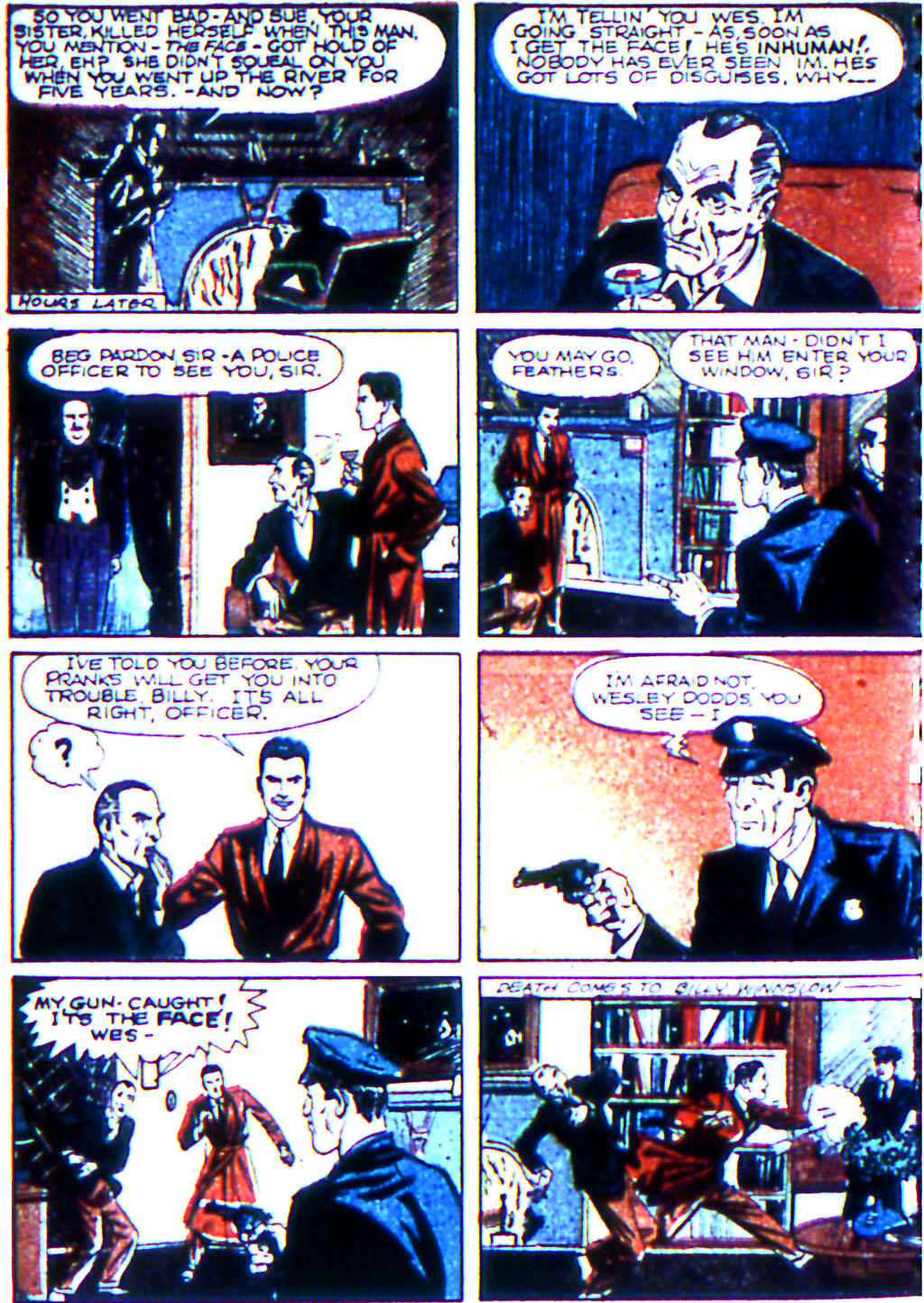 Unfortunately, things are far from all right. A panicked Billy Winslow attempts to draw his weapon when he recognizes the policeman as none other than The Face himself - a man he has cautioned Dodds has "got lots of disguises". Unfortunately, the sneak thief's gun snags itself upon his pants pocket, The Face guns him down, and Dodds is shot as he lunges at the killer.
.jpg)
"I'm The Face you fools! To think such as you could trap him!"
Following a week's convalescence inside a hospital room, Wesley Dodds visits the official uniform maker for the police in his guise of The Sandman. Although his presence is detected - and summarily dealt with when our hero discharges the contents of his gas gun upon the unfortunate employee who crosses his path - The Sandman gets the information he's come for via a ledger informing him that one Gus Olssen recently rented a police man's outfit. Paying a visit to Olssen's ramshackle abode, The Sandman finds that the man is indeed one The Face's hired hands from a note reminding him of an appointment with the criminal mastermind at "the warehouse at 1:30".  Conveniently, Olssen arrives with an associate at just this time to retrieve the message meaning that so long as he stays out of sight, The Sandman simply has to trail them once they leave to discover the location of this warehouse. That's exactly what happens and precisely what he does. Dispensing with the lookout man when he arrives, the mystery man watches from a skylight window as The Face outlines his plan for his henchman. "Frowser, when Billy Winslow was killed, he almost discovered my identity. You know me only as "The Face" I intend to stay that way. Yet this Winslow had some interests in an Oklahoma oil well I framed him to get him out of the way. The oil well is hot! Winslow and his sister were worth millions. I haven't been successful in finding any heirs so you go out to Oklahoma and pretend to be a cousin. Get the set up?"
Handing over an envelope to the underling containing his further instructions and documents required to make the insidious scheme succeed supplies too good a cue for The Sandman to resist. Crashing through the skylight, our hero douses Frowser with some gas as The Face takes off running. Figuring that The Face expects him to read the instructions now left in his possession, The Sandman gambles that rather than take the train to Oklahoma to carry out the deception himself, he'll head to the airport. Knowing the route he'll have to take to accomplish this plan, The Sandman is on sight when The Face rides the tracks via a handcar. Earlier in this tale our defender of the weak and helpless remarked to himself, "If Wesley Dodds takes an interest in The Face it will be too bad for him!" Those words are backed up tenfold when The Face, pumping furiously away at his handcar atop the railroad trestle carrying over the river, is met head-on by The Sandman as he rams him with his car. The Face falls "toward a cold death" and The Sandman gets in the last word. "And so ends the threat of The Face! Oh well, it was fun while it lasted!"
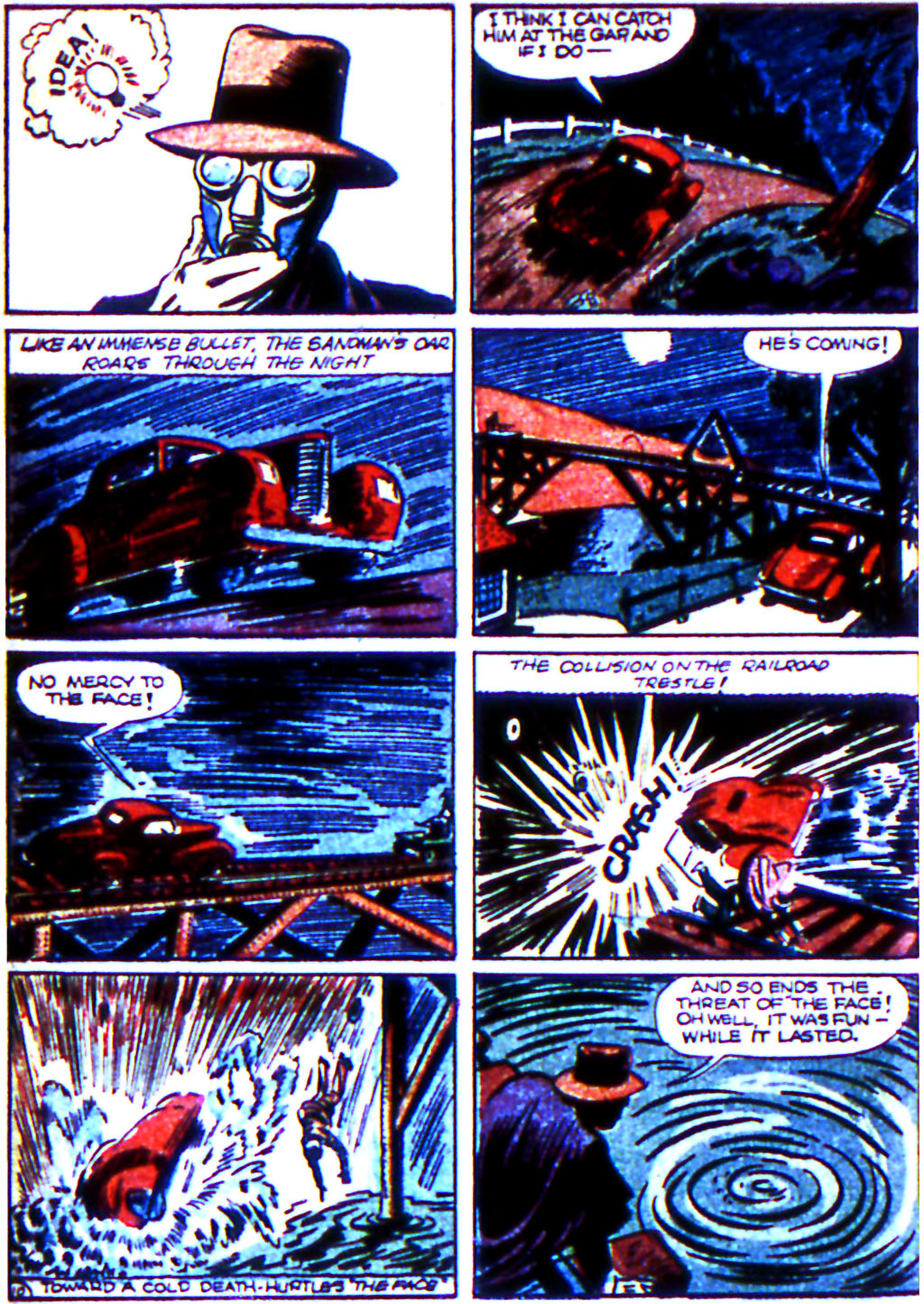 Thoughts Thoughts: I want to touch upon a moment from this tale which I skipped over in my summary - that of Wesley Dodds' actions and train of thought following his discharge from the hospital. He presents his theory that The Face wore a genuine police uniform when he killed Billy Winslow (and shot Dodds himself) to the Police Commissioner directly. Discounting the implied suggestion that one of his own men could have been involved in the shooting (a position which Dodds emphatically agrees with though his declaration of "I tell you it was a policeman who shot me!" of just a moment prior doesn't sound like as ringing an endorsement as his follow-up comments) The Commissioner provides Dodds with the name of his force's uniform supplier. From there, The Sandman takes charge. The fact that this could conceivably implicate Dodds himself isn't a detail Fox leaves unaddressed. After securing Olssen's name from the uniform maker's establishment, The Sandman's playboy alter ego ensures that he's seen at a popular nightclub three sheets to the wind. "Wes Dodds - drunk! Must have been hitting it up for hours!"
Such is the observation of muck-raking gossip columnist, Rennie McCavoy who prints this little tidbit in his column the following day. Exactly Dodds intentions since it provides a convenient alibi should The Police Commissioner contemplate The Sandman following up Dodds' lead. 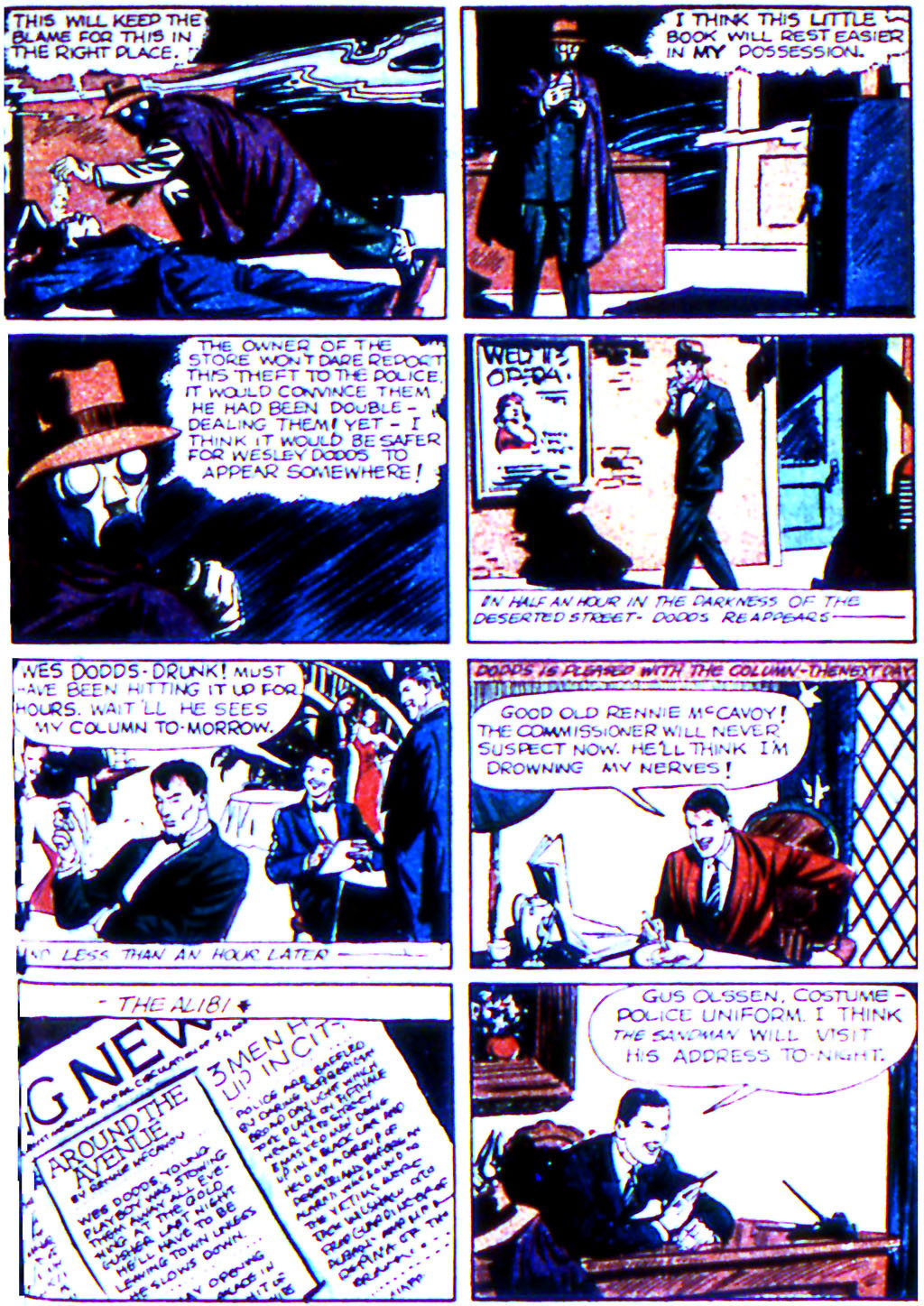 As I mentioned in my first review, I always enjoy seeing these little side streets the good guy has to hopscotch down on their way between the more pressing stages of their main plan. I suppose that a lifetime of reading comics has inured me to the dangers bullets which don't directly enter the heart or brain pose since it isn't the gunshot to the chest sustained by Dodds which resonates with me so much as this self-inflicted blow to his reputation. Such attention to the byproducts of the hero's master plan isn't uncommon in very early Golden Age stories such as these - a time predating the period when "everyone is taking their cues from earlier superhero comics" as Cody so astutely noted - and is always appreciated on my part at least. Public intoxication feels like one of those subjects which isn't quite taboo enough to merit an objection from any editor looking for something which might illicit raised eyebrows from any concerned parent, but at the same time, seems just crude enough that in a short little while it'll be a depiction of our hero most writers will know not to take a chance on. Speaking of which... That bullet to the chest might not linger in my memory, but I suspect from how The Sandman deals with The Face that he's not letting go of that grudge anytime soon. I've seen Superman hurl torturers through the air like a javelin, Batman shoulder toss bad guys off of rooftops in self-defense, but ramming a villain head-on with your car while shouting, "No mercy to The Face!" at full throttle as he's using an old-timey handcart to make his getaway? Wow! Dodds must have really been stewing in that week's stay in the hospital to resort to this. And yes, The Face does remain dead after this story as there will be no more appearances hereafter. It's a shame too, since he's a formidable foe what with his skill at mimicry enabling him to go wherever he pleases. Gaining entry into The Sandman's own home as a policeman, gunning down both Dodds and the man he attempts to protect, and then sticking around long enough to scold the pair for daring to try and defy him has all the earmarks of a great beginning for a classic foe (The Joker would later pull a similar stunt in his debut appearance in 1940) - shame that this is it for him. And it might be the end of Feathers the butler too depending on whether or not his employer decided to sack him for leading a crazed killer into his house. Or Feathers - as Cei-U! noted - might just be good old Humphries making his second appearance in the series. I suppose it's a reflection of Gardner Fox's workload that he forgot that he gave Wesley Dodds' butler a very serviceable and dignified surname in his previous contribution to the run since I can't visualize the writer smacking himself in the forehead and exclaiming, "'Humphries??' What sort of butler name is 'Humphries'?? What was I thinking?? I should have called him 'Feathers'! Now THAT'S a name for a butler!" Or perhaps "Feathers" is just the nickname Dodds applies to Humphries whenever he does something he considers disagreeable such as help a policeman arrest of one of his friends. Could be that it's short for Featherbrain. So after too very un-Sandmanish chapters in the saga, Fox picks up where he left off with an entry which realizes the full potential of the character. Getting flung from the whirlwind pace of his world the moment he lets his guard down (the bullet to the chest) to leaping back on the merry-go-round and refusing to take any prisoners once he does. Shot in the chest, leaping through skylights, drunkenly carousing late into the evening, and a climax in which he drives his car at full throttle into oncoming traffic and goes over the side with his victim - the lack of a follow-up to this one might very well have been due to doctor's orders that if he wanted to live to see 30, Fox had to ease up on the excitement. Sandman Mystery Theatre will introduce their own take on The Face some 50 years later and I would argue that the perverse - with every possible definition of that word being considered fair game - and diseased rendering which artist, John Watkiss' supplies him with is well within arm's reach of how Creig Flessel (making his debut as interior penciller for The Sandman with this installment) depicts him here. It's as if Matt Wagner instructed Watkiss to read the original chronicle as quickly as he could before trying to recreate The Face's visage from memory. The results may be a little more pronounced in 1993 but the essentials were all there from the start. The mouth without lips, dead empty slits for eyes, the hollow cheekbones like that of a reptile - I really don't know if this is supposed to be The Face's true appearance (which wouldn't make sense if he's looking to keep his identity a secret) or a disguise (which also wouldn't make sense since I can't imagine any police officer looking like that).  But what else can I say about Flessel's work here? Well, despite seeing The Sandman adorned in his classic green suit - which also premieres here - which might suggest a back to basic look after a couple of installments showcasing Frog-Man Sandman and Sky-Man Sandman, he's beginning to look more like a superhero than mystery man to my eyes here. He doesn't loom over that skylight so much as hunch over it; he doesn't really prowl through the streets like a shadow as he does streak through the alleys like a bolt; and that drop into The Face's hideout seems just a little more clumsy than I'd like. The little 'IDEA!' lightbulb which literally appears above his head when he hits upon the strategy of ramming The Face with his car doesn't feel all that pulpish to me either, but those moments aside, Flessel makes a fine successor to Christman (whose finer lines I happen to still prefer). And in the interest of giving credit where credit's due, he's still turning in covers which grip the reader by the eyeballs with every chance he's given. As Flessel noted about them in The Sandman Archives Vol.1, "[DC] needed somebody to do them. They'd say, 'We need a cover for The Sandman. Do something.' The covers were my ideas, my work, and generally there were no complaints." Certainly none from me.   |
|